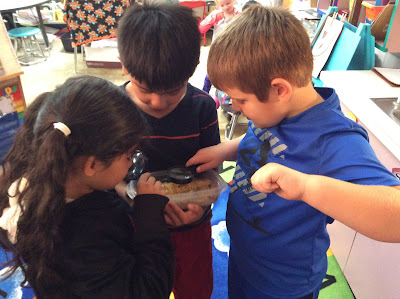That's So Corny: A Science Investigation Packet with Indian Corn
 |
| That's So Corny! Cover Page |
If you have been reading my previous posts, you know that I just finished sharing my Science Experiments and Investigations Packet called: Let's Fall Into Science. Then I decided to pull out some of those experiments and investigations separately to share on Teachers Pay Teachers.
So, last year I decided to enter a Science Fair Project at my school. We did this as a class and we investigated with Indian Corn. The students really learned a lot about the Scientific Method and about growing corn.
This is a very easy and engaging science investigation!
You can teach this mini-unit during your theme of Natural Resources, Life Cycles, or Thanksgiving. I like to teach this min-unit in November when we are learning about Natural Resources and Thanksgiving. It goes perfectly together!
This packet includes:
3 days of Lesson Plans with Mentor Texts
Corn Life Cycle Vocabulary Cards
Scientific Method Vocabulary Cards
Parts of a Corn Cob Vocabulary Card
Interactive Notebook activities for math and science
Craftivity: Corn in the Cornfield and Expository Writing
Science Investigation Log: That's So Corny!
So, here's how you set this investigation up: First you need Indian Corn, and if you cannot find some, Yellow Corn will do just fine. Just make sure to shuck it first before putting it into the Tupperware. You also need 3 Tupperware containers filled with different natural resources: sand, soil and water. Here's a picture of my corn in their three different natural resources:
 |
| Corn in Water, Sand and Soil |
How are going to hook your students in? You can set the stage by reading your first book of Corn by: Gail Gibbons. This mentor text is perfect to give an overview of corn before you start.
You can use this scientific method fold-able for the students to ask their question and hypothesize about the corn. The students can glue this into their science notebook and fill it in as the investigation unfolds. Here is my fold-able.
 |
| Scientific Method Fold-able |
 |
| Hypothesis Page |
Here are pictures of my students observing the corn in the different natural resources. They put their thumbs down if they didn't think it will grow, and put their thumbs up if they did think it will grow. They did this by table groups:
 | ||
Students Observing Corn
|
 |
| Data Page Day 1 |
Also in the packet, the students can create a craftivity. I LOVE incorporating art with my science and social studies units. The students can write an expository piece all about corn and then make a cornfield using real popcorn! Here is my craftivity:
 |
| Corn in the Cornfield Craftivity |
 | ||||
| Student Making the Craftivity Students can also learn the parts of a corn cob using this vocabulary card:
|










































